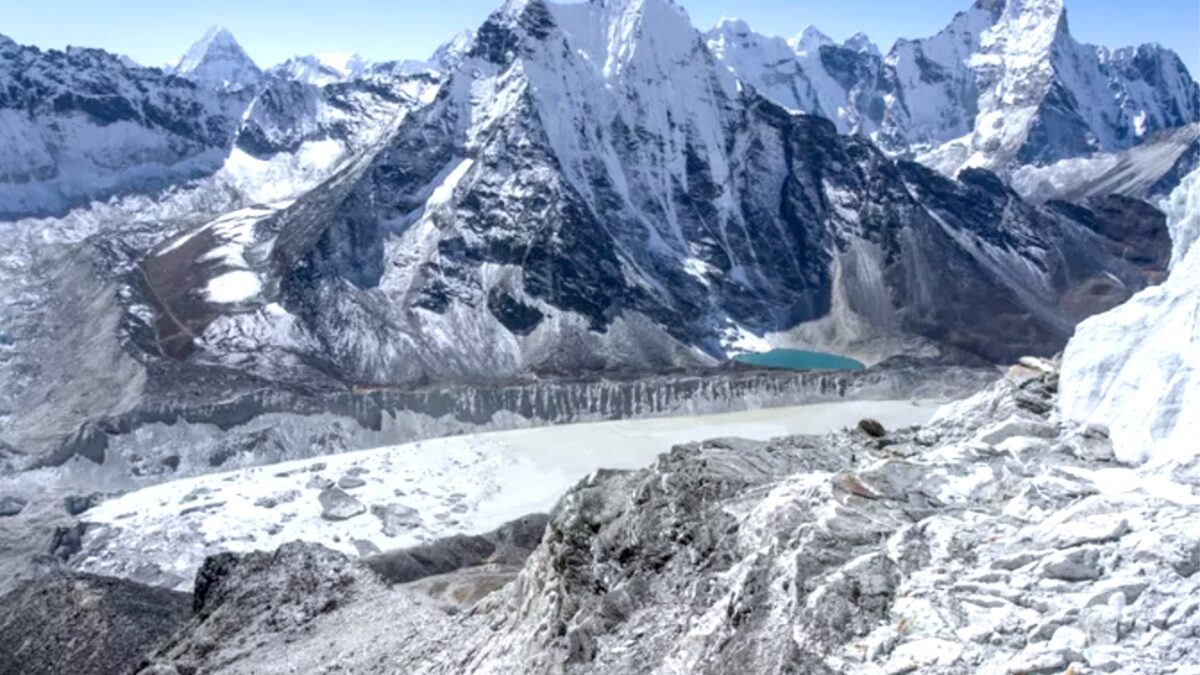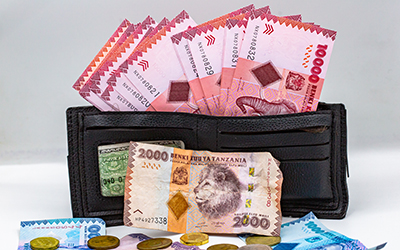France riots: Almost 1,000 arrested in fresh night of riots in France amid warning to British travellers
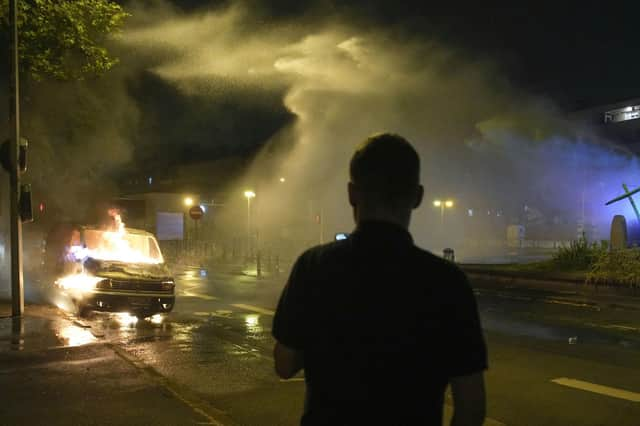
Rioting raged in cities around France for a fourth night despite massive police deployment – with cars and buildings set ablaze and stores looted as family and friends prepared to bury the 17-year-old whose killing by an officer sparked the unrest.
The government suggested the violence was beginning to lessen thanks to tougher security measures, but damages remained widespread, from Paris to Marseille and Lyon and French territories overseas, where a 54-year-old died after being hit by a stray bullet in French Guiana.
The interior ministry announced 994 arrests around France by early on Saturday.
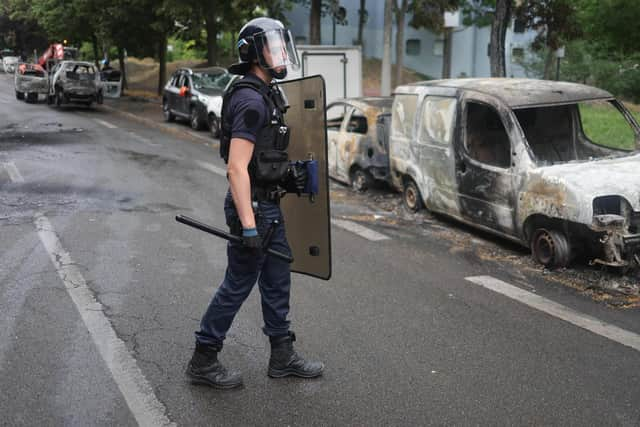
France’s national football team — including international star Kylian Mbappe, an idol to many young people in the disadvantaged neighbourhoods where the anger is rooted — have pleaded for an end to the violence.
“Many of us are from working-class neighbourhoods, we too share this feeling of pain and sadness” over the killing of 17-year-old Nahel, the players said in a statement.
“Violence resolves nothing.
“There are other peaceful and constructive ways to express yourself.”
They said it is time for “mourning, dialogue and reconstruction” instead.
The deadly shooting of Nahel, whose last name has not been made public, stirred up long-simmering tensions between police and young people in housing projects who struggle with poverty, unemployment and racial discrimination.
The subsequent rioting is the worst France has seen in years and puts new pressure on President Emmanuel Macron, who appealed to parents to keep children off the streets and blamed social media for fuelling violence.
Family and friends were holding a funeral gathering on Saturday for Nahel in his hometown of Nanterre.
Anger erupted in the Paris suburb after his death there on Tuesday and quickly spread nationwide.
Early on Saturday, firefighters in Nanterre extinguished blazes set by protesters that left scorched remains of cars strewn across the streets.
In the neighbouring suburb of Colombes, protesters overturned bins and used them for makeshift barricades.
Looters during the evening broke into a gun shop and made off with weapons in the Mediterranean port city of Marseille, police said.
Officers in Marseille arrested nearly 90 people as groups of protesters lit cars on fire and broke shop windows to take what was inside.
Buildings and businesses were also vandalised in the eastern city of Lyon, where a third of the roughly 30 arrests made were for theft, police said.
Authorities reported fires in the streets after an unauthorised protest drew more than 1,000 people earlier on Friday evening.
2,500 fires
The Interior Ministry said 994 arrests were made during the night, with more than 2,500 fires.
The night before, 917 people were arrested nationwide, 500 buildings targeted, 2,000 vehicles burned and dozens of shops ransacked.
While the number of overnight arrests was the highest yet, there were fewer fires, cars burned and police stations attacked around France than the previous night, according to the Interior Ministry.
Interior minister Gerald Darmanin said the violence was of “much less intensity”.
Hundreds of police and firefighters have been hurt, including 79 overnight, but authorities have not released injury tallies for protesters.
Nanterre mayor Patrick Jarry said France needs to “push for changes” in disadvantaged neighbourhoods.
Despite repeated government appeals for calm and stiffer policing, Friday saw brazen daylight violence too.
An Apple shop was looted in the eastern city of Strasbourg, where police fired tear gas, and the windows of a fast-food outlet were smashed in a Paris-area shopping centre, where officers repelled people trying to break into a shuttered shop, authorities said.
In the face of the escalating crisis that hundreds of arrests and massive police deployments have failed to quell, Mr Macron held off on declaring a state of emergency, an option that was used in similar circumstances in 2005.
Instead, his government ratcheted up its law enforcement response, with 45,000 police deployed overnight. Some were called back from annual leave.
Warning to British tourists
British travellers have been warned to be aware of the unrest in France.
Newly updated Foreign Office travel advice warns of potential disruption and cautions people to be aware of the uncertain situation.
It states: “Since June 27, riots have taken place across France. Many have turned violent. Shops, public buildings and parked cars have been targeted.
“There may be disruptions to road travel and local transport provision may be reduced. Some local authorities may impose curfews.
“Locations and timing of riots are unpredictable. You should monitor the media, avoid areas where riots are taking place, check the latest advice with operators when travelling and follow the advice of the authorities.”
Pressure piles on Macron as French
protesters set fires
Despite heavy security presence, night time looting takes place in the cities of Lyon, Marseille and Grenoble with bands of often hooded rioters pillaging shops and setting cars and garbage bins on fire.
REUTERS
The unrest was sparked by the killing of 17-year-old Nahel, which revived longstanding grievances about policing and racial profiling in France's low-income and multi-ethnic suburbs. / Photo: Reuters
French police have arrested 994 people nationwide during a fourth consecutive night of protests over the killing of a teenager by police, the interior ministry said Saturday.
France had deployed 45,000 officers overnight backed by light armoured vehicles and crack police units to quell the violence over the death of 17-year-old Nahel, killed during a traffic stop in a Paris suburb on Tuesday.
Young protesters clashed with police and looted stores in France, piling more pressure on President Emmanuel Macron after he appealed to parents to keep children off the streets and blamed social media for fueling unrest.
Despite repeated government appeals for calm and stiffer policing, Friday saw brazen daylight violence, too.
An Apple store was looted in the eastern city of Strasbourg, where police fired tear gas, and the windows of a fast-food outlet were smashed in a Paris-area shopping mall, where officers repelled people trying to break into a shuttered store, authorities said.
The southern port city of Marseille, initially spared the violence that broke out first in the Paris region, was experiencing its second night of upheaval.
Even before nightfall, young people hurled projectiles, set fires, and looted shops, police said. They made almost 90 arrests.
On Friday evening, looters broke into a Marseille gun shop and made off with weapons, and a man was later arrested with a hunting rifle, police said.
The previous night, two off-duty officers suffered serious injuries, including one who was stabbed, when they were set upon by about 20 people, police said.
Authorities in the city of Lyon reported rioters again setting fires and pelting police in the suburbs.
In the city centre, police made 21 arrests to stop the attempted looting of shops after an unauthorised protest against police violence that drew about 1,300 people on Friday evening.
The unrest was sparked by the killing of Nahel, which revived longstanding grievances about policing and racial profiling in France's low-income and multi-ethnic suburbs.
In her first media interview since the shooting, Nahel's mother, Mounia, told France 5 television: "I don't blame the police, I blame one person: the one who took the life of my son."
She said the 38-year-old officer responsible, who was detained and charged with voluntary manslaughter on Thursday, "saw an Arab face, a little kid, and wanted to take his life".
Nahel's burial is scheduled for Saturday, according to Nanterre Mayor Patrick Jarry, who said France needs to "push for changes" in disadvantaged neighbourhoods.


AP
Police officers face protesters on Concorde square during a protest in Paris.
Spillovers elsewhere
Violence was also erupting in some of France's overseas territories.
In French Guiana, a 54-year-old was killed by a stray bullet on Thursday night when protesters fired at police in the capital, Cayenne, authorities said.
On the small Indian Ocean island of Reunion, protesters set garbage bins ablaze, thrown projectiles at police, and damaged cars and buildings, officials said in a statement.
To maintain security, 150 officers will be deployed on Friday night and through the weekend, officials said.
In Belgium, police made 63 arrests so far, 48 of which are minors.
Demonstrations late on Thursday in central Brussels saw protesters smash windows at bus stops and set vehicles on fire.
There were also protests in Lemonnier that prompted the closure of the Anneessens metro station.


AP
People run away during clashes with police in the center of Lyon.
Macron zeros in on social media
In the face of an escalating crisis that hundreds of arrests and massive police deployments have failed to quell, Macron held off on declaring a state of emergency, an option that was used in similar circumstances in 2005.
Instead, his government ratcheted up its law enforcement response.
Already massively beefed-up police forces were boosted by another 5,000 officers for Friday night, increasing the number to 45,000 overall, the interior minister said.
Some were called back from vacation.
The minister, Gerald Darmanin, said police made 917 arrests on Thursday alone and noted their young age — 17 on average.
He said more than 300 police officers and firefighters have been injured.
Macron, too, zeroed in on social media platforms that have relayed dramatic images of cars and buildings being torched and other acts of violence, saying they are playing a "considerable role" in the violence.
The unrest comes just over a year before Paris, and other French cities rattled by violence are due to host 10,500 Olympians and millions of visitors for the Summer Olympic Games.
The Paris 2024 organising committee said it was closely monitoring the situation and that preparations for the Olympics continued.
2023-July-1

TEHRAN (FNA)- The number of demonstrators arrested in Brussels rose to 63 on Friday as protests sparked by the killing of a teen by police in France spread to Belgium.
The arrests came after fighting between protesters and police in the Anneessens area, with 48 minors arrested, Anadolu news agency reported.
Demonstrations late Thursday in central Brussels saw protesters smash windows at bus stops and set vehicles on fire.
There were also protests in Lemonnier that prompted the closure of the Anneessens metro station.
France has seen a wave of violent protests since a police officer shot 17-year-old Nahel M. in the Paris suburb of Nanterre on June 27.
According to local media, a group of young people issued a call on social media in support of the demonstrations in France over the death of the teenager, identified as Nahel M., who was shot and killed by a police officer on Tuesday in Nanterre after failing to stop during a traffic check.
Nahel’s death sparked protests in Nanterre, leading to overnight clashes between demonstrators and police.
The 38-year-old police officer who killed Nahel was detained by the General Inspectorate of the National Police (IGPN) as part of an investigation into the intentional homicide by the Nanterre prosecutor’s office.
Marseille mayor urges government to send additional troop reinforcements
1/07/2023 Saturday
AA
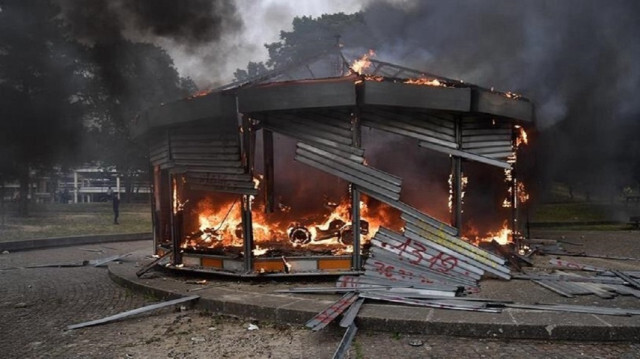
France deploys armored vehicles as police fail to contain demonstrators
France sent armored vehicles into the streets Friday as authorities failed to contain demonstrations which entered a fourth straight night that was sparked by the killing of a teen by police.
Armored vehicles were deployed to squares in regions and cities, including in the second city, Marseille, in the Woippy commune less than 20 miles from the Luxembourg border. And in the community of Nanterre on the northwestern outskirts of Paris.
In Toulouse, police arrested 19 people due to violence as an apartment building was set on fire.
Marseille Mayor Benoit Payan urged the government to send additional troop reinforcements. "Scenes of looting and violence are unacceptable," he said.
Interior Minister Gerald Darmanin said 270 people have been arrested, with more than 80 of them in Marseille.
A 19-year-old male died Friday after he fell from the roof of a supermarket around 5 a.m. local time in northwestern France during protests, the France Bleu Normandie newspaper reported.
France has seen a wave of violent protests since a police officer shot dead Nahel M., 17, in the Paris suburb of Nanterre on June 27.
More than 900 arrested overnight as rioters clash with police around France
1 July 2023, 08:24
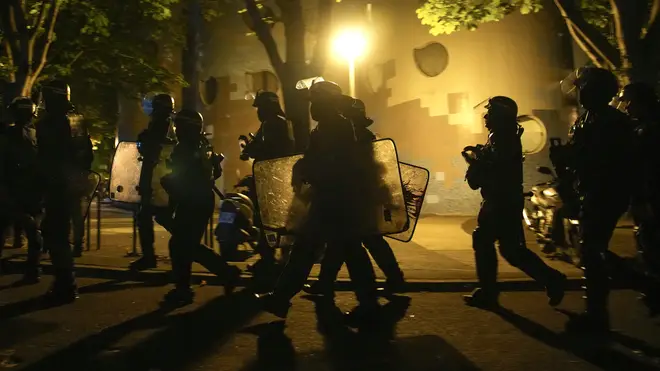
The deadly shooting of a 17-year-old boy by a police officer has sparked riots across the country.
Rioting raged in cities around France for a fourth night despite massive police deployment – with cars and buildings set ablaze and stores looted as family and friends prepared to bury the 17-year-old whose killing by an officer sparked the unrest.
The government suggested the violence was beginning to lessen thanks to tougher security measures, but damages remained widespread, from Paris to Marseille and Lyon and French territories overseas, where a 54-year-old died after being hit by a stray bullet in French Guiana.
The interior ministry announced 994 arrests around France by early on Saturday.
France’s national football team — including international star Kylian Mbappe, an idol to many young people in the disadvantaged neighbourhoods where the anger is rooted — have pleaded for an end to the violence.
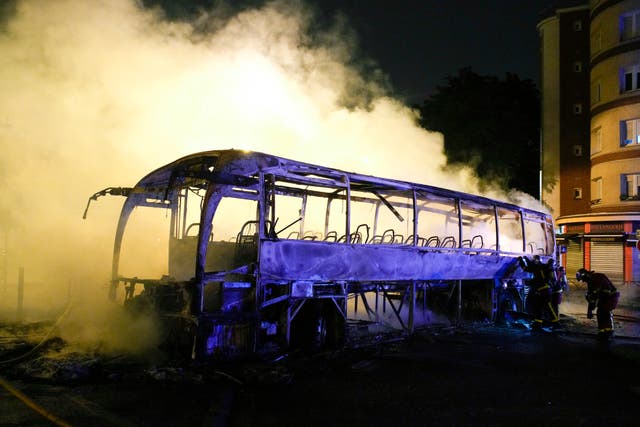
“Many of us are from working-class neighbourhoods, we too share this feeling of pain and sadness” over the killing of 17-year-old Nahel, the players said in a statement.
“Violence resolves nothing.
“There are other peaceful and constructive ways to express yourself.”
They said it is time for “mourning, dialogue and reconstruction” instead.
The deadly shooting of Nahel, whose last name has not been made public, stirred up long-simmering tensions between police and young people in housing projects who struggle with poverty, unemployment and racial discrimination.
The subsequent rioting is the worst France has seen in years and puts new pressure on President Emmanuel Macron, who appealed to parents to keep children off the streets and blamed social media for fuelling violence.
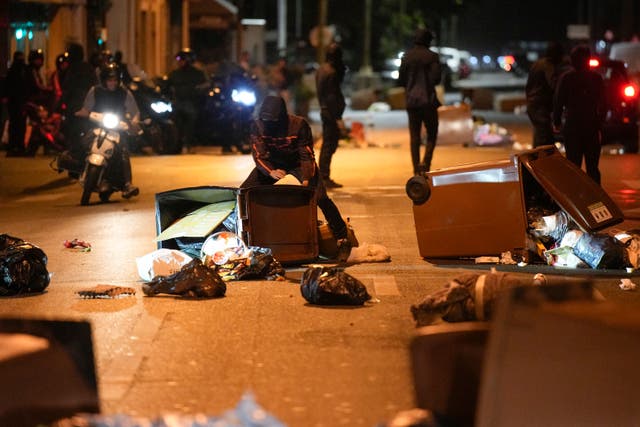
Family and friends were holding a funeral gathering on Saturday for Nahel in his hometown of Nanterre.
Anger erupted in the Paris suburb after his death there on Tuesday and quickly spread nationwide.
Early on Saturday, firefighters in Nanterre extinguished blazes set by protesters that left scorched remains of cars strewn across the streets.
In the neighbouring suburb of Colombes, protesters overturned bins and used them for makeshift barricades.
Looters during the evening broke into a gun shop and made off with weapons in the Mediterranean port city of Marseille, police said.
Officers in Marseille arrested nearly 90 people as groups of protesters lit cars on fire and broke shop windows to take what was inside.
Buildings and businesses were also vandalised in the eastern city of Lyon, where a third of the roughly 30 arrests made were for theft, police said.
Authorities reported fires in the streets after an unauthorised protest drew more than 1,000 people earlier on Friday evening.
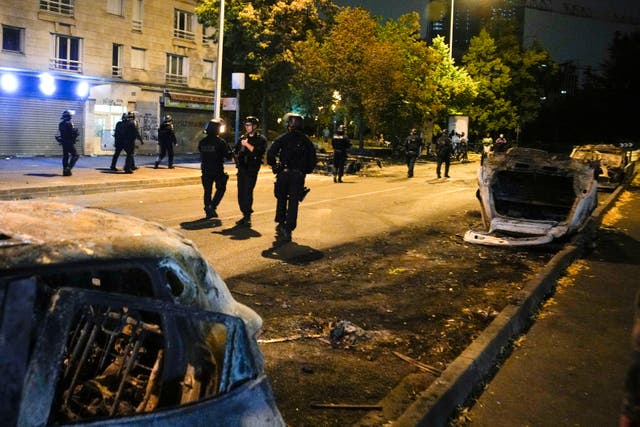
The Interior Ministry said 994 arrests were made during the night, with more than 2,500 fires.
The night before, 917 people were arrested nationwide, 500 buildings targeted, 2,000 vehicles burned and dozens of shops ransacked.
While the number of overnight arrests was the highest yet, there were fewer fires, cars burned and police stations attacked around France than the previous night, according to the Interior Ministry.
Interior minister Gerald Darmanin said the violence was of “much less intensity”.
Hundreds of police and firefighters have been hurt, including 79 overnight, but authorities have not released injury tallies for protesters.
Nanterre mayor Patrick Jarry said France needs to “push for changes” in disadvantaged neighbourhoods.
Despite repeated government appeals for calm and stiffer policing, Friday saw brazen daylight violence too.
An Apple shop was looted in the eastern city of Strasbourg, where police fired tear gas, and the windows of a fast-food outlet were smashed in a Paris-area shopping centre, where officers repelled people trying to break into a shuttered shop, authorities said.
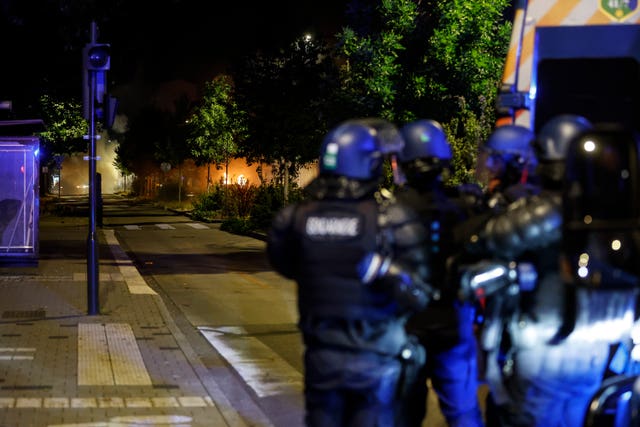
In the face of the escalating crisis that hundreds of arrests and massive police deployments have failed to quell, Mr Macron held off on declaring a state of emergency, an option that was used in similar circumstances in 2005.
Instead, his government ratcheted up its law enforcement response, with 45,000 police deployed overnight. Some were called back from annual leave.
Mr Darmanin ordered a nationwide nighttime shutdown on Friday of all public buses and trams, which have been among rioters’ targets.
He also said he warned social networks not to allow themselves to be used as channels for calls to violence.
“They were very co-operative,” Mr Darmanin said, adding that French authorities were providing the platforms with information in hopes of co-operation identifying people inciting violence.
“We will pursue every person who uses these social networks to commit violent acts,” he said.
Mr Macron, too, zeroed in on social media platforms that have relayed dramatic images of vandalism and cars and buildings being torched.
Singling out Snapchat and TikTok, he said they were being used to organise unrest and served as conduits for copycat violence.

The violence comes just over a year before Paris and other French cities are due to host 10,500 Olympians and millions of visitors for the summer Olympic Games.
Organisers said they are closely monitoring the situation as preparations for the Olympics continue.
The police officer accused of killing Nahel was handed a preliminary charge of voluntary homicide.
Preliminary charges mean investigating magistrates strongly suspect wrongdoing but need to investigate more before sending a case to trial.
Nanterre prosecutor Pascal Prache said his initial investigation led him to conclude that the officer’s use of his weapon was not legally justified.
Nahel’s mother, identified as Mounia M, told France 5 television she was angry at the officer but not at the police in general.
“He saw a little Arab-looking kid; he wanted to take his life,” she said.
“A police officer cannot take his gun and fire at our children, take our children’s lives.”
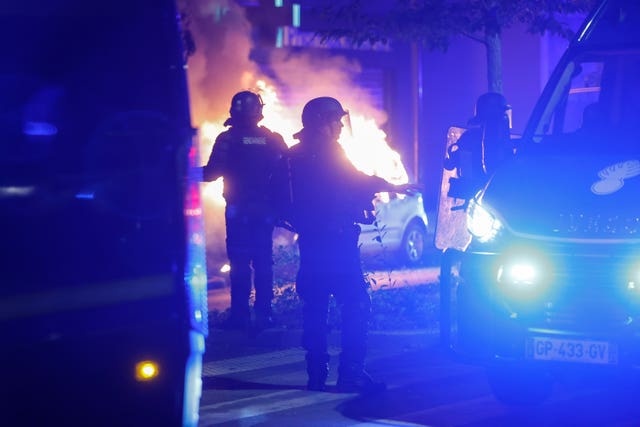
The family has roots in Algeria.
Race was a taboo topic for decades in France, which is officially committed to a doctrine of colourblind universalism.
In the wake of Nahel’s killing, French anti-racism activists renewed complaints about police behaviour.
Thirteen people who did not comply with traffic stops were shot dead by French police last year.
This year, another three people, including Nahel, died under similar circumstances.
The deaths have prompted demands for more accountability in France, which also saw racial justice protests after George Floyd’s killing by police in Minnesota.
This week’s protests echoed the three weeks of rioting in 2005 that followed the deaths of 15-year-old Bouna Traore and 17-year-old Zyed Benna, who were electrocuted while hiding from police in a power substation in Clichy-sous-Bois.
Who was Nahel M.? The 17-year-old whose death sparked riots across France
'He did all he was asked. He had real potential'
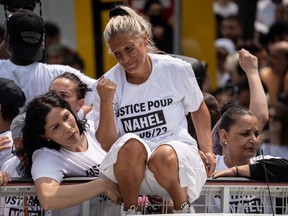
Article content
Protests have erupted across France after a teenager was fatally shot by police on Tuesday. Nahel M., 17, was shot in the chest at point blank range while driving away from a traffic stop in the Paris suburb of Nanterre.
Close to 40,000 police officers have been deployed to quell the violent unrest that is entering its fourth night. More than 875 demonstrators have been arrested and 200 police officers injured while authorities struggle to restore calm.
Here’s what we know about the boy whose death has provoked outrage across France:
Who is Nahel?
The teenager, identified only as Nahel M., was an only child raised by a single mother in Nanterre, a working-class suburb located 15km from central Paris.
For the past three years, Nahel played for a community rugby team, Pirates of Nanterre, run by Ovale Citoyen, a program that aims to help young people struggling in school enter the job market.
Jeff Puech, president of the association, said Nahel was someone “who used rugby to get by.”
“He was someone who had the will to fit in socially and professionally, not some kid who dealt in drugs or got fun out of juvenile crime,” he told Le Parisien, praising Nahel’s “exemplary attitude.”
“He did all he was asked. He had real potential.”
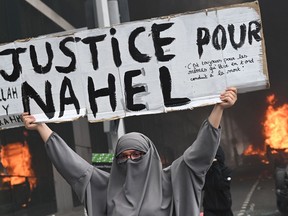
Nahel enrolled at a college to study for an electrician’s certificate in the town of Sureness in 2021.
The teenager was due to appear in juvenile court in September after allegedly failing to comply with a traffic stop last weekend, BBC reported. Nahel was working as a food delivery driver and the trouble he was in involved mostly involved cars, the outlet said.
The family’s lawyer has said Nahel has never been sentenced for a crime.
Advertisement 4
What happened during the shooting?
Two officers on motorbikes who pursued Nahel said they saw him commit traffic violations including driving through a crosswalk and endangering a pedestrian and cyclist, LeMonde reported.
The officers caught up with Nahel in traffic and pointed guns at him to “dissuade him from restarting (the vehicle) by asking him to turn off the ignition,” according to the officers.
A video of the incident appears to show no immediate danger to the two officers.
A voice can be heard threatening to shoot the teenager dead. As the car slowly pulls away, the officer near the driver side window fires the fatal shot.
The officer who fired the shot has been detained and charged with voluntary homicide.
“Conditions for the legal use of a firearm were not met,” Parch said.
What has his family said?
Nahel’s mother, identified as Mounia M., told broadcaster France 5 she wants “very firm” justice for the officer who killed her only child but said she does not blame the police force.
The officer “saw an Arab face, a little kid, and wanted to take his life,” she said.
“A police officer cannot take his gun and fire at our children, take our children’s lives,” she added.
Lawyers for Nahel’s family have called for action against the second officer.
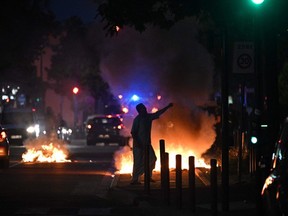
What is the officer facing charges Nahel saying?
A lawyer for the officer said his client was “devastated” and didn’t intend to kill the teenager. Laurent-Franck Liénard told BMFTV his client has asked for forgiveness from the family and had acted in accordance to the law, citing concern for the safety of the officers and others.
Why were police officers pointing guns during a traffic stop?
A 2017 law created in response to extremist attacks says law enforcement can shoot at a vehicle after a failure to comply with an order when “occupants are likely to perpetrate, in their flight, attacks on their life or physical integrity or that of others.”
However, according to AP, an internal security code requires that weapons are only authorized for use under “absolute necessity and in a strictly proportionate manner.”
The Yael Braun-Pivet, president of France’s lower House of Parliament, has called for a review of how the law allowing police gun use is being used, according to the outlet.
Last year, thirteen people died in police shootings in France for not complying with order during a traffic stop, according to police. This year, three people, including Nahel, have died in similar circumstances.
In a 2022 study, researchers linked the rise in fatal police shootings in France to the 2017 law. A comparison of the years before and after the law was implemented showed was a five fold increase in the number of fatal shootings on moving vehicles, according to the study.
Riots erupt in French Caribbean territories in reaction to unrest in France over teen's death
SAN JUAN, Puerto Rico (AP) — Riots have erupted in French Caribbean territories to protest the police shooting death of a teenager in a Paris suburb, with at least one person killed as people set fire to dumpsters and damaged buildings.
The worst violence so far was in French Guiana, where authorities said that police officers came under fire and that a stray bullet killed a 54-year-old government worker late Thursday in the capital, Cayenne.
Columns of thick black smoke rose above some neighborhoods in Cayenne, turning streets hazy as police tried to quell protesters in the small territory on the shoulder of South America. Authorities urged calm as the territory braced for another possible night of rioting.
Officials said Friday that the man who was killed worked in the government’s mosquito control office and was on his balcony when he was hit by the bullet.
“(It’s) a level of violence that is difficult to understand,” Public Safety Director Philippe Jos told reporters.
French Guiana’s prefect, Thierry Queffelec, said businesses and public transportation would shut down early on Friday evening, and he announced a temporary ban on the sale and transportation of gasoline at night. He also said some 300 officers would be deployed Friday night along with drones and helicopters.
At least six people had been arrested, including five minors. No one was charged in the killing of the government worker.
Smaller demonstrations also were reported in the French Caribbean islands of Martinique and Guadeloupe, where no injuries or deaths were reported.
Residents in the French Caribbean, where racial tensions have long simmered and where some feel oppressed and ignored by France, have identified with those protesting the teen's killing in France, where officials are grappling with rioting across the country.
Unrest also appeared in other French overseas territories, including on the Indian Ocean island of Reunion. Since Wednesday, protesters there have set garbage bins ablaze, thrown projectiles at police during clashes and damaged cars and buildings, regional officials said in a news release.
___
Associated Press writer Claire Rush in Portland, Oregon, contributed to this report.
Dánica Coto, The Associated Press
France arrests over 1,300 in massive riots over Paris teen's death
Story by By REUTERS • July 1,2023
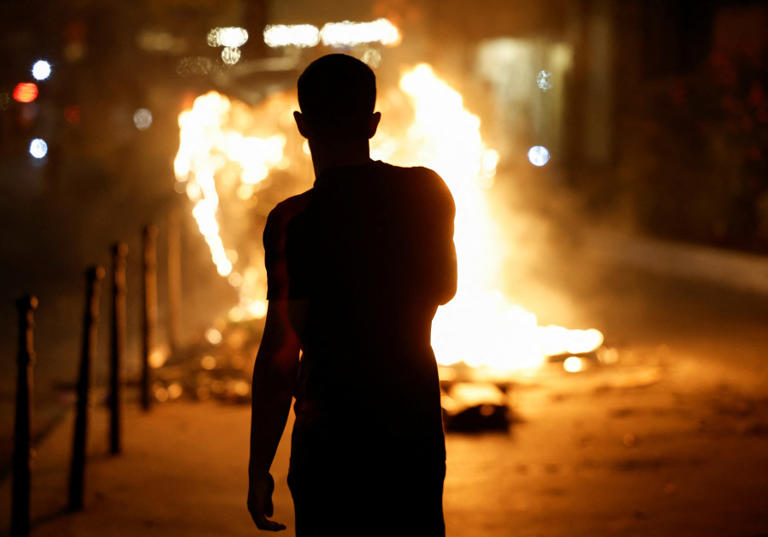
A person stands near a burning container as people protest following the death of Nahel, a 17-year-old teenager killed by a French police officer in Nanterre during a traffic stop, and against police violence, in Paris, France, June 30, 2023
More than 1,300 people were arrested in France during a fourth night of rioting before the funeral on Saturday of Nahel M, whose shooting by police sparked the unrest, in the Paris suburb where the teenager died.
The government deployed 45,000 police and several armored vehicles overnight to tackle the worst crisis of President Emmanuel Macron's leadership since the "Yellow Vest" protests which brought much of France to a standstill in late 2018.
Macron postponed a state visit to Germany that was due to begin on Sunday due to the unrest, both countries said.
The interior ministry said on Twitter that 1,311 people had been arrested overnight, compared with 875 the previous night, although the violence was "lower in intensity."
Nahel, a 17-year-old of Algerian and Moroccan descent, was shot by a police officer during a traffic stop on Tuesday in the Paris suburb of Nanterre, where buses were halted and the area quiet on a damp Saturday morning after more overnight rioting.
Several hundred people lined up to enter Nanterre's grand mosque, which was guarded by volunteers in yellow vests, while a few dozen bystanders watched from across the street.
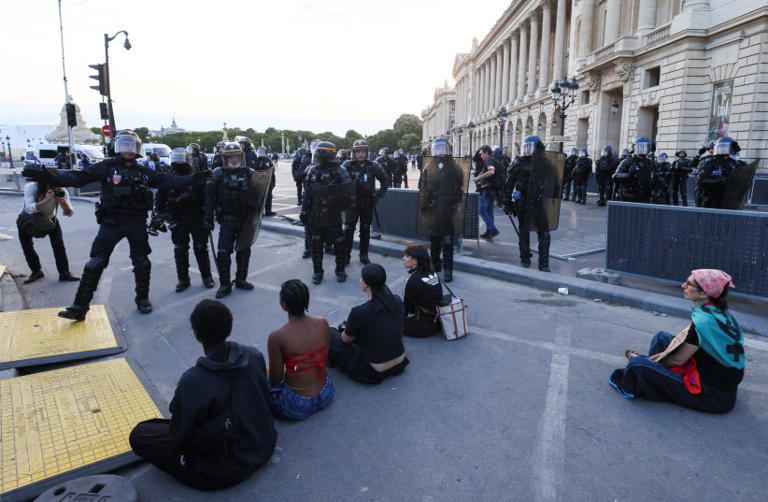
Some of the mourners, their arms crossed, said "God is Greatest" in Arabic, as they spanned the boulevard in prayer.
The shooting of the teenager, caught on video, has reignited longstanding complaints by poor and racially mixed urban communities of police violence and racism. Macron had denied there is systemic racism in French law enforcement agencies.
"If you have the wrong skin color, the police are much more dangerous to you," said a young man, who declined to be named, adding that he was a friend of Nahel's.
Lootesr ransack shops across French cities
Looters have ransacked dozens of shops and torched 2,000 vehicles since the start of the riots, which have spread to cities such as Marseille, Lyon, Toulouse, Strasbourg and Lille.
More than 200 police officers have been injured, Interior Minister Gerald Darmanin said, adding that the average age of those arrested was 17.
Friday night's arrests included 80 people in Marseille, home to many people of North African descent.
Rioters in France's second-largest city had looted a gun store and stole hunting rifles, but no ammunition, police said.
Mayor Benoit Payan called on the government to send extra troops to tackle "pillaging and violence" in Marseille, where three police officers were slightly wounded on Saturday.
In Lyon, France's third-largest city, police deployed armored personnel carriers and a helicopter, while in Paris, they cleared protesters from the Place de la Concorde. Lyon Mayor Gregory Doucet has also called for reinforcements.
Darmanin had asked local authorities to halt buses and trams, while Macron urged parents to keep children at home.
The unrest has revived memories of nationwide riots in 2005 that forced then-President Jacques Chirac to declare a state of emergency, after the death of two young men electrocuted in a power substation as they hid from police.
"Quite simply, we're not ruling out any hypothesis and we'll see after tonight what the President of the Republic chooses," Darmanin said on Friday when asked whether the government could declare a state of emergency.
Players from the national soccer team issued a rare statement calling for calm. "Violence must stop to leave way for mourning, dialog and reconstruction," they said on star Kylian Mbappe's Instagram account.
Events including two concerts at the Stade de France on the outskirts of Paris were canceled, while Tour de France organizers said they were ready to adapt to any situation when the cycle race enters the country on Monday from Spain.
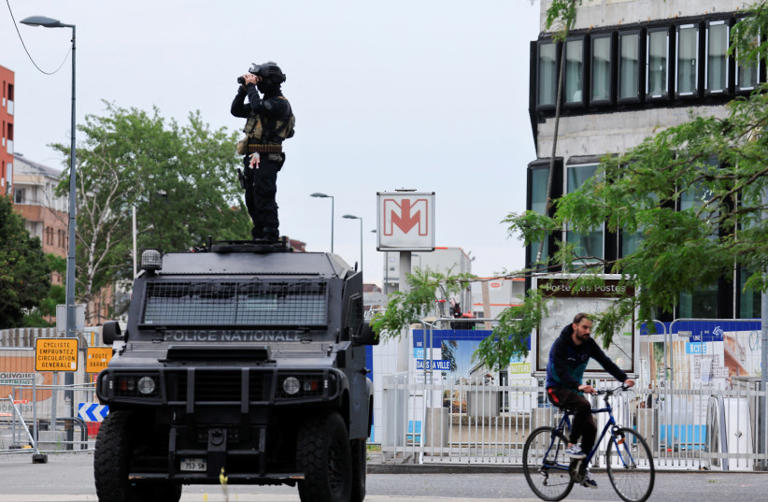
A French Recherche Assistance Intervention Dissuasion (RAID) special police unit member stands on his armoured car and uses his binoculars to check a protest following the death of Nahel, a 17-year-old teenager killed by a French police officer in Nanterre during a traffic stop, in Lille, France
Macron had left an EU summit in Brussels on Friday early to attend a second cabinet crisis meeting in two days and asked social media to remove "the most sensitive" footage of rioting and to disclose identities of users fomenting violence.
The policeman whom prosecutors say acknowledged firing a lethal shot at Nahel is in preventive custody under formal investigation for voluntary homicide, equivalent to being charged under Anglo-Saxon jurisdictions.
His lawyer, Laurent-Franck Lienard, said his client had aimed at the driver's leg but was bumped when the car took off, causing him to shoot toward his chest. "Obviously (the officer) didn't want to kill the driver," Lienard said on BFM TV.



